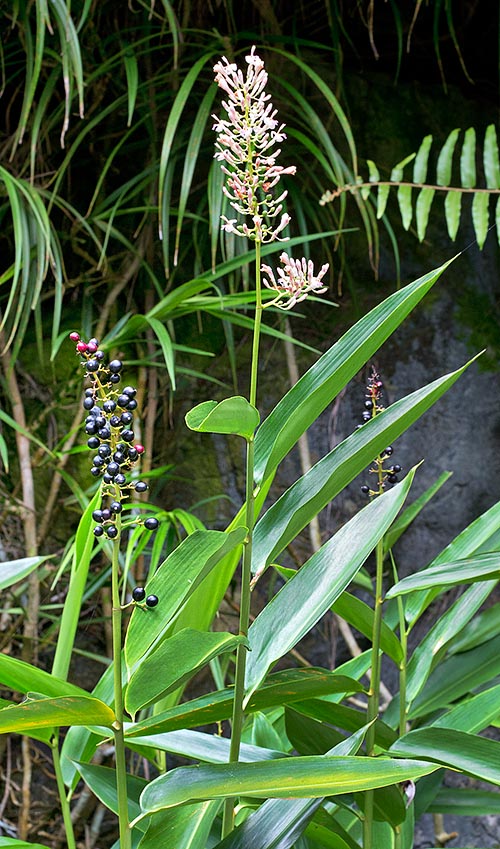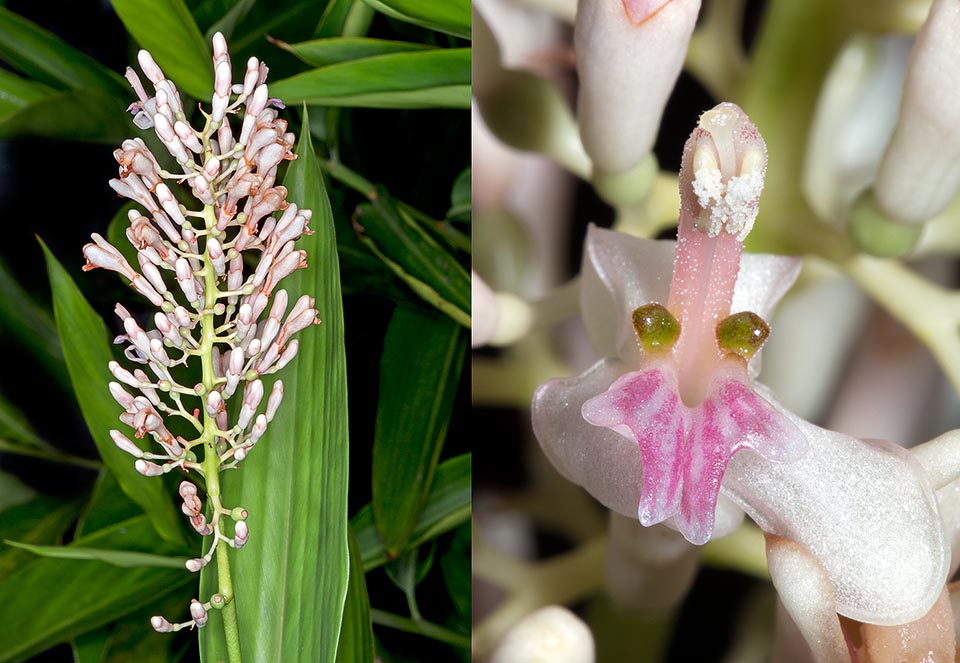Family : Zingiberaceae

Text © Pietro Puccio

English translation by Mario Beltramini

Perennial herbaceous with 0,5-1,8 m pseudostems, Alpinia aquatica grows in south-eastern Asian swamps. The rhizome is used by natives as antifungal for skin diseases © Giuseppe Mazza
The genus is honoured to the Italian physician and botanist Prospero Alpini (1553-1617); the specific name is the Latin adjective “aquaticus, a, um” = aquatic, living in the water, with obvious reference.
Common names: aquatic galangal (English); shui shan jiang (Chinese); lengkuas (Borneo); meroyan siamang, munkanang (Malaysia).
The Alpinia aquatica (Retz.) Roscoe (1807) is an evergreen, rhizomatous, perennial herbaceous species, with thin, 0,5-1,8 m long pseudo-stems, and leaves, on a 1,2 cm long petiole, alternated, lanceolate with long pointed apex, 15-22 cm long and 2-5 cm broad, coriaceous, of bright green colour.
Panicle terminal inflorescence, 15-25 cm long, with flowers having white tridented campanulate calyx, 0,8-1 cm long, corolla with about 1 cm long tube and 3 oblong lobes with rounded apex, 1,2-1,5 cm long, trilobed pink labellum, 2 cm long and 1,2 cm broad, with bifid median lobe and rounded lateral ones with one oblong gland at the base, 1 cm long linear filament, and reddish anther.
The fruits are globose capsules of about 0,6 cm of diameter, initially green, then red and finally blackish when ripe, usually containing 3-5 trigonal seeds.
It reproduces by seed, previously kept in lukewarm water for two days, in organic loam with addition of siliceous sand or agri-perlite for a 30%, to improve the drainage, at the temperature of 22-24 °C, with variable germination times that can vary among 1 and 6 months, but usually and easily by division of the rhizomes.
Requires a tropical or subtropical climate, permanently humid soils and exposition in full sun or partial shade, is at times utilized as ornamental in parks and gardens at the margins of ponds or in aquatic gardens.
Cultivable also in pot, to be sheltered during the coldest months where the climate does not allow the continuos permanence in open air, in draining organic loam in very luminous position and with lowest temperature values preferably not under the 15 °C.
Locally, the rhizome is used in the popular medecine as antifungal in the skin diseases.

Panicle terminal inflorescence, 15-25 cm long, with flowers having white tridented campanulate calyx, 0,8-1 cm long, corolla with about 1 cm long tube and 3 oblong lobes with rounded apex, 1,2-1,5 cm long, trilobed pink labellum, 2 cm long and 1,2 cm broad, with bifid median lobe and rounded lateral ones with one oblong gland at the base, 1 cm long linear filament, and reddish anther. The fruits are globose capsules of about 0,6 cm of diameter, initially green, then red and finally blackish © Giuseppe Mazza
Synonyms: Languas aquaticum (Retz.) J.Koenig (1783); Heritiera aquatica Retz. (1791); Hellenia aquatica (Retz.) Willd. (1797); Martensia aquatica (Retz.) Raeusch. (1797); Hellenia melanocarpa Teijsm. & Binn. (1862); Alpinia fraseriana Oliv. (1887); Alpinia melanocarpa (Teijsm. & Binn.) Ridl. (1899); Alpinia rosella Ridl. (1899); Alpinia exostylis K.Schum. (1904); Alpinia cornu-cervi Ridl. (1906); Alpinia rubella Ridl. (1910); Alpinia quadriloba Ridl. (1926); Languas cornu-cervi (Ridl.) Merr. (1929); Languas exostylis (K.Schum.) Merr. (1929); Languas fraseriana (Oliv.) Merr. (1929); Languas rubella (Ridl.) Merr. (1929); Languas melanocarpa (Teijsm. & Binn.) Burkill (1930).
